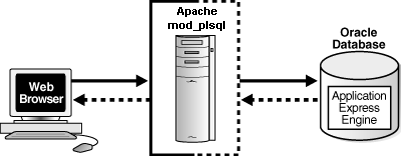Understanding Oracle Application Express Architecture |
 Previous |
 Next |
Oracle Application Express lives completely within your Oracle database. It is comprised of data in tables and PL/SQL code.
Whether you are running the Oracle Application Express development environment or an application you built using Oracle Application Express, the process is the same. Your browser sends a URL request that is translated into the appropriate Oracle Application Express PL/SQL call. After the database processes the PL/SQL, the results are relayed back to your browser as HTML. This cycle happens each time you either request or submit a page.
The application session state is managed in the database tables within Application Express. It does not use a dedicated database connection. Instead, each request is made through a new database session, consuming minimal CPU resources.
About Apache and the Embedded PL/SQL Gateway
The version of Oracle database you use determines how the URL is translated:
-
Versions prior to Oracle Database 11.1 require Oracle HTTP Server (Apache) with
mod_plsql. The following graphic illustrates that architecture.
Description of the illustration arch.gif
-
With Oracle Database 11.1 or higher or Oracle Database 10g Express Edition, you can remove Oracle HTTP Server (Apache) from the architecture and replace it with the embedded PL/SQL gateway. The following graphic illustrates the architecture using the emedded PL/SQL gateway.

Description of the illustration arch_epg.gif
The embedded PL/SQL gateway provides the Oracle database with a Web server and also the necessary infrastructure to create dynamic applications. The embedded PL/SQL gateway runs in the XML database HTTP server in the Oracle database and includes the core features of mod_plsql, but does not require the Oracle HTTP Server powered by Apache. Inclusion of the embedded PL/SQL gateway simplifies the architecture and eliminates the middle tier entirely.
About the Application Express Engine
The Application Express engine renders and processes pages. It also performs these tasks:
-
session state management
-
authentication services
-
authorization services
-
page flow control
-
validations processing